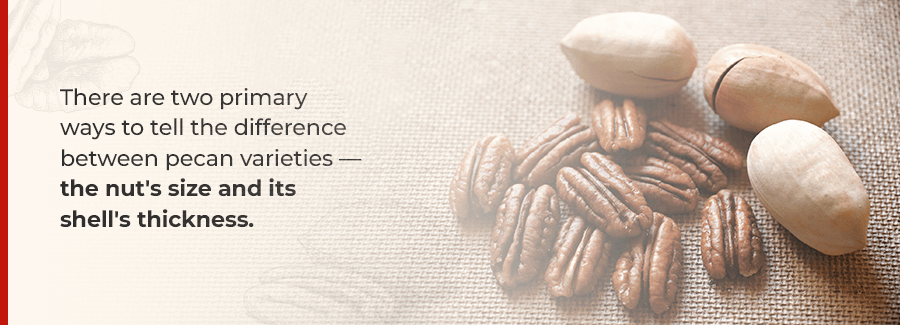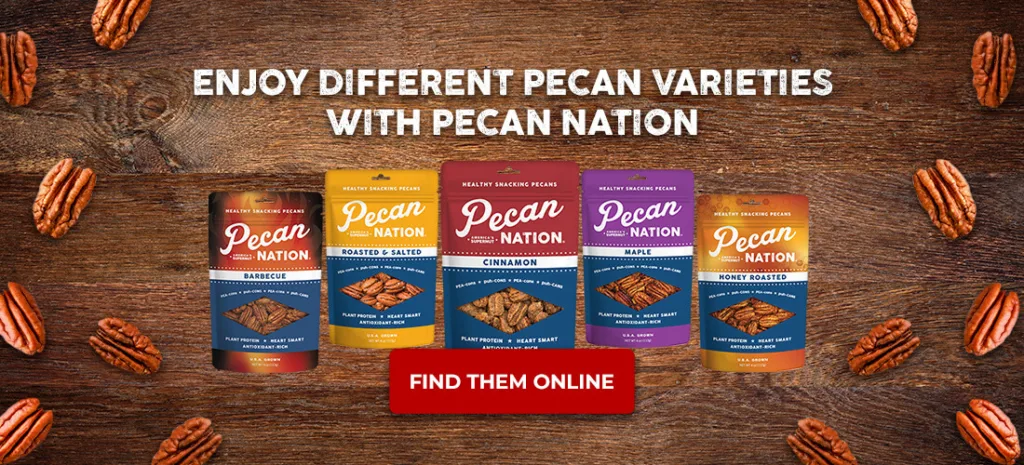
What Are the Differences in Pecan Varieties?
Pecans are an incredibly versatile type of nut that you’ll find in baked goods and recipes and as a right-out-of-the-bag snack. But no two varieties are the same, and some are better suited to certain purposes than others. Some are sweet, and some are savory. Some have thin shells, and others are thicker. Whatever form they take, pecans are full of health benefits and possess one of the highest antioxidant capacities among nut species.
Let’s take a look at the many types of pecans available and how they compare.
How Many Types of Pecans Are There?
Many people think pecans are just pecans, but there are actually over 1,000 varieties of this tasty nut. The Mississippi River and its tributaries are at the heart of the native range of pecan trees, which stretches across Central and Southern United States and into Northern Mexico. These river valleys offer the rich, well-drained soils pecans need to thrive.
While pecans don’t grow naturally in the wild anywhere else in the world, they’re cultivated in several other countries, including Brazil, South Africa, Israel and Peru! The pecan species, Carya illinoinensis, is considered one of North America’s most valuable nut crops. It’s a type of hickory tree in the walnut family, Juglandaceae.

Types of Pecans and Pecan Varieties
Nowadays, you can choose pecan types cultivated for their flavor, shell thickness and other qualities. One of the easiest ways to differentiate between pecan varieties is to look at the nut’s size and its shell’s thickness. A native pecan often has thicker shells and smaller nuts, while improved varieties tend to have more delicate shells and larger nuts.
Another clue in identifying different pecan varieties is the nut shape and kernel appearance. Some pecans are round, while others are football-shaped. Kernel appearance includes the shell’s texture and the depth and width of its grooves.
Pecan varieties can also differ due to the pecan tree itself. The growing climate plays a role here. Pecan trees thrive in U.S. Department of Agriculture (USDA) plant hardiness zones 6 through 9. While these trees can also live in zone 5, they will not produce nuts there. Regions with warm, lengthy growing seasons and few nighttime temperature drops provide the ideal climate for pecan production.
Now that you know what qualities make pecan tree varieties different, let’s explore just a taste of the different types available.
1. Cape Fear Pecans
Cape Fear pecans are native to North Carolina. These nuts are large, with a medium-thin shell that’s easy to crack, revealing a high-quality, meaty kernel.
This somewhat new variety offers a buttery, nutty profile that’s perfect for baking. The robust flavor can happily co-exist with other ingredients that might overwhelm more delicate flavors. Try it in a Classic Pecan Pie to see it in action!
2. Schley Pecans
With their high oil content and thin shells, Schley pecans have a delightful flavor and crack easily. They are medium to large in size and do well in the arid, humid conditions of America’s Southwest region and the Southeast.
Their oily nature makes them a good pick for nut flours or nut oils, which work well in cold food applications like vinaigrettes and soups. This variety of pecan was the parent of many modern varieties.
Schley pecans are one of the varieties we use here at Pecan Nation, and many people like them for their wonderful, intense flavor.
3. Desirable Pecans
Desirable pecans are medium-large pecans with a soft shell that makes them easy to crack. They can get so big that they’re also called a “mammoth” pecan.
The Desirable tree offers consistent quality year after year. Its nuts are meaty inside and packed with a light, sweet, smooth flavor. You can roast them and enjoy them as a snack.
These pecans, also used at Pecan Nation, are one of the top varieties in the Southeastern U.S. and ripen in late October and early November.
4. Mahan Pecans
Popular in the Southeast U.S., Mahan pecans are very large nuts with soft shells. The tree produces a lot of nuts, prefers dry climates with warm Winters and ripens from mid- to end-November.
These nuts tend to be rich in flavor, making them a good fit for baked goods and straight-up snacking. If you need whole nuts, such as for decorating a dessert, the large Mahan variety works well and can stand up to competing flavors.
5. Osage Pecans
The Osage pecan is small or medium in size, with a quality kernel and a sweet, oily taste. Its rich flavor makes it an enjoyable snack and a great ingredient for culinary uses.
These pecans grow best in the Northern U.S. and ripen at the beginning of September. The Osage pecan tree is highly disease-resistant, making it productive.
6. Farley Pecans
Farley pecans are another variety we use at Pecan Nation. They have a rich flavor and release easily from their shell.
Farley pecans are on the rarer side, but they offer sweetness and crunch. They work well with different seasonings and can add some texture to dishes like salads. Many people like to use the grooves of the Farley pecan to hold onto flavorful pockets of seasonings like salt, cinnamon and sugar.
7. Stuart Pecans
The Stuart pecan has a thicker shell than typical thin-shell pecans. This variety has generously sized nuts and is one of the most common. It has a classic taste with a slight sweetness and firm texture, pairing well with savory recipes like Pecan Crusted Cream Cheese Balls and charcuterie boards.
Stuart pecans grow well farther North than other pecan types. However, the Stuart tree takes eight to 10 years before it can bear any nuts.
8. Elliot Pecans
Elliot pecans, another variety Pecan Nation uses, are smaller, smooth and have a teardrop shape and a medium-thick shell. The trees can grow as tall as 70 to 100 feet, making them one of the largest pecan tree varieties. They offer excellent nut quality, flavor and consistency.
The nut itself has a buttery, rich flavor with a subtle hint of hickory. Elliot pecans are an excellent snacking variety when eaten on their own, but they’re also ideal for pies and other sweets. They offer a luxurious taste in each bite.
What Are the Best Pecans for Baking?
If you’re cooking or baking, the best pecan variety depends on what you are aiming for with flavor, size or color. As you now know, there is a lot of variety among pecan varieties, so some of your decisions will come down to personal preference. However, some home cooks prefer to use specific pecan varieties in the kitchen.
The Stuart pecan, also known as an all-purpose pecan, is excellent for chopping and mixing into many different recipes. The Cape Fear pecan has a mild flavor and is popular in the confectionery industry.
The Desirable pecan is ideal for decorating dishes due to its large size. It is also the most readily available pecan variety, so you can probably find it on the shelves of your favorite grocery store. The Desirable pecan cooks and freezes well, making it a typical commercial baking choice.
Pecans with thin shells, like Farley and Schley, make a convenient snack since they are easy to crack open. These varieties are also ideal for baking because they are sweet. The best way to discover which pecan variety you like best is to try them all!
If you hope to grow pecans at home, the best varieties depend on your growing climate and the traits you desire most. If you live in a more humid or arid area, you may not have the optimal conditions to grow specific pecan varieties. You must also consider when you would like to harvest, how many pecans you want to grow per tree and how big you want the nuts to be. Deciding to grow pecans can take some research, but it will hopefully lead to a bountiful harvest.
How to Identify Pecan Trees
With so many different pecans available, it stands to reason that they grow on highly varied trees. Identifying a pecan tree can be tricky, but if you know what to look for, you can figure out what’s growing on those branches.
Generally speaking, pecan trees are tall, boasting an average height of about 70 feet, with long, distinct-looking leaflets. The leaves themselves reach almost two feet long and have 17 small leaflets branching off from the center. The distinctive part comes from their curved shape, reminiscent of a sickle, in which the leaflets are slightly bowed at the tips.
Pecan trees tend to stick together, so a lone tree is less likely to be a pecan tree. More commonly, you’ll see at least a trio of pecan trees.
Knowing how to identify pecan tree varieties is a little trickier, especially if you’re looking at the tree when it isn’t producing any nuts. Take a look at the following characteristics to see if you can find any clues:
- Location: Some varieties grow best or are more popular in certain areas of the country. Mahan and Desirable pecans, for example, are big in the Southeast, while Stuart pecans are one of the few varieties you might find more North.
- Pollinators: Many tree varieties work well with certain other pecan types that act as complementary pollinators. For example, Stuart is a Type II pollinator, while Desirable is a Type I pollinator. If you find a Type I pecan tree, you might find a Type II close by and vice versa.
- Nut size and shape: If you have a pecan available, it can tell you what variety of tree you’re looking at. Some are very distinct, like the oblong Schley pecan. Its size can also give you a clue. Varieties like Osage and Elliot pecans tend to be smaller, while Mahan and Desirable pecans are some of the largest.
- Kernel size and texture: Kernels may take on different colors and textures. Cape Fear pecans, for example, have a lovely light gold color. Some varieties have especially wrinkled or smooth textures.
Enjoy Different Pecan Varieties With Pecan Nation
Are you looking to try different pecan varieties? Choose amazingly tasty pecans from Pecan Nation. We grow, clean, crack, cook, package and ship over 40 pecan varieties, including Schley, Farley, Elliot and Desirable.
For five generations, we have grown the tastiest and highest-quality pecans, ideal for snacking or baking. We control the source of our pecans, ensuring quality in each bag.
Try our delectable Cinnamon, Maple, Honey Roasted, Barbecue, Roasted & Salted and Natural flavors. Find them online or in-store.

